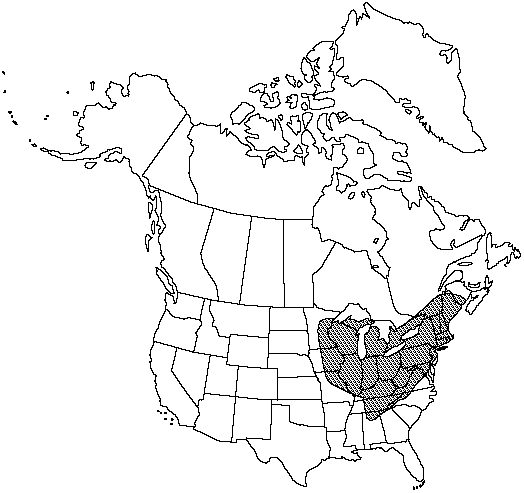Difference between revisions of "Dryopteris goldiana"
Manual 631. 1848.
FNA>Volume Importer |
FNA>Volume Importer |
||
| (5 intermediate revisions by the same user not shown) | |||
| Line 8: | Line 8: | ||
}} | }} | ||
|common_names=Goldie's wood fern;dryoptère de goldie | |common_names=Goldie's wood fern;dryoptère de goldie | ||
| − | |basionyms={{Treatment/ID/ | + | |basionyms={{Treatment/ID/Basionym |
|name=Aspidium goldianum | |name=Aspidium goldianum | ||
|authority=Hooker ex Goldie | |authority=Hooker ex Goldie | ||
| + | |rank=species | ||
| + | |publication_title=Edinburgh Philos. J. | ||
| + | |publication_place=6: 333. 1822 | ||
}} | }} | ||
|synonyms= | |synonyms= | ||
| Line 20: | Line 23: | ||
}}<!-- | }}<!-- | ||
| − | --><span class="statement" id="st- | + | --><span class="statement" id="st-undefined" data-properties=""><b>Leaves </b>monomorphic, dying back in winter, 35–120 × 15–40 cm. <b>Petiole</b> 1/3 length of leaf, scaly at base; scales scattered, dark, glossy brown to nearly black, with pale border. <b>Blade</b> green, often white-mottled at tip, ovate, tapering abruptly at apex, pinnate-pinnatifid to 2-pinnate at base, herbaceous, not glandular. <b>Pinnae</b> parallel to plane of blade, ovate-lanceolate, broadest above base; basal pinnae broadly oblong-lanceolate, slightly reduced, basal pinnule equal to adjacent pinnules, basal basiscopic pinnule and basal acroscopic pinnule equal; pinnule margins crenulate or serrate. <b>Sori</b> nearer midvein than margin. <b>Indusia</b> and axes lacking glands. <b>2n</b> = 82.</span><!-- |
-->{{Treatment/Body | -->{{Treatment/Body | ||
| Line 26: | Line 29: | ||
|elevation=50–1500 m | |elevation=50–1500 m | ||
|distribution=N.B.;Ont.;Que.;Ala.;Conn.;Del.;Ga.;Ill.;Ind.;Iowa;Ky.;Maine;Md.;Mass.;Mich.;Minn.;Mo.;N.H.;N.J.;N.Y.;N.C.;Ohio;Pa.;R.I.;Tenn.;Vt.;Va.;W.Va.;Wis. | |distribution=N.B.;Ont.;Que.;Ala.;Conn.;Del.;Ga.;Ill.;Ind.;Iowa;Ky.;Maine;Md.;Mass.;Mich.;Minn.;Mo.;N.H.;N.J.;N.Y.;N.C.;Ohio;Pa.;R.I.;Tenn.;Vt.;Va.;W.Va.;Wis. | ||
| − | |discussion=<p>Dryopteris goldiana is diploid and is one of the parents of D. celsa and of D. clintoniana. Dryopteris goldiana hybridizes with five species. Hybrids can be identified by the glossy dark scales and large blade size. A remarkable additional hybrid (× Dryostichum singulare W. H. Wagner), involving this species and Polystichum lonchitis, is known from Gray and Simcoe counties, Ontario. It is intermediate between the parents and is sterile (W. H. Wagner Jr., F. S. Wagner et al. 1992).</p> | + | |discussion=<p><i>Dryopteris goldiana</i> is diploid and is one of the parents of <i>D. celsa</i> and of <i>D. clintoniana</i>. <i>Dryopteris goldiana</i> hybridizes with five species. Hybrids can be identified by the glossy dark scales and large blade size. A remarkable additional hybrid (× Dryostichum singulare W. H. Wagner), involving this species and <i>Polystichum lonchitis</i>, is known from Gray and Simcoe counties, Ontario. It is intermediate between the parents and is sterile (W. H. Wagner Jr., F. S. Wagner et al. 1992).</p> |
|tables= | |tables= | ||
|references= | |references= | ||
| Line 35: | Line 38: | ||
-->{{#Taxon: | -->{{#Taxon: | ||
name=Dryopteris goldiana | name=Dryopteris goldiana | ||
| − | |||
|authority=(Hooker ex Goldie) A. Gray | |authority=(Hooker ex Goldie) A. Gray | ||
|rank=species | |rank=species | ||
| Line 49: | Line 51: | ||
|publication year=1848 | |publication year=1848 | ||
|special status= | |special status= | ||
| − | |source xml=https://jpend@bitbucket.org/aafc-mbb/fna- | + | |source xml=https://jpend@bitbucket.org/aafc-mbb/fna-data-curation.git/src/f50eec43f223ca0e34566be0b046453a0960e173/coarse_grained_fna_xml/V2/V2_759.xml |
|genus=Dryopteris | |genus=Dryopteris | ||
|species=Dryopteris goldiana | |species=Dryopteris goldiana | ||
| − | |||
| − | |||
| − | |||
| − | |||
| − | |||
| − | |||
| − | |||
| − | |||
| − | |||
| − | |||
| − | |||
| − | |||
| − | |||
| − | |||
| − | |||
| − | |||
| − | |||
| − | |||
| − | |||
| − | |||
| − | |||
| − | |||
| − | |||
| − | |||
| − | |||
}}<!-- | }}<!-- | ||
-->[[Category:Treatment]][[Category:Dryopteris]] | -->[[Category:Treatment]][[Category:Dryopteris]] | ||
Latest revision as of 21:52, 16 December 2019
Leaves monomorphic, dying back in winter, 35–120 × 15–40 cm. Petiole 1/3 length of leaf, scaly at base; scales scattered, dark, glossy brown to nearly black, with pale border. Blade green, often white-mottled at tip, ovate, tapering abruptly at apex, pinnate-pinnatifid to 2-pinnate at base, herbaceous, not glandular. Pinnae parallel to plane of blade, ovate-lanceolate, broadest above base; basal pinnae broadly oblong-lanceolate, slightly reduced, basal pinnule equal to adjacent pinnules, basal basiscopic pinnule and basal acroscopic pinnule equal; pinnule margins crenulate or serrate. Sori nearer midvein than margin. Indusia and axes lacking glands. 2n = 82.
Habitat: Dense, moist woods, especially ravines, limey seeps, or at the edge of swamps
Elevation: 50–1500 m
Distribution

N.B., Ont., Que., Ala., Conn., Del., Ga., Ill., Ind., Iowa, Ky., Maine, Md., Mass., Mich., Minn., Mo., N.H., N.J., N.Y., N.C., Ohio, Pa., R.I., Tenn., Vt., Va., W.Va., Wis.
Discussion
Dryopteris goldiana is diploid and is one of the parents of D. celsa and of D. clintoniana. Dryopteris goldiana hybridizes with five species. Hybrids can be identified by the glossy dark scales and large blade size. A remarkable additional hybrid (× Dryostichum singulare W. H. Wagner), involving this species and Polystichum lonchitis, is known from Gray and Simcoe counties, Ontario. It is intermediate between the parents and is sterile (W. H. Wagner Jr., F. S. Wagner et al. 1992).
Selected References
None.
